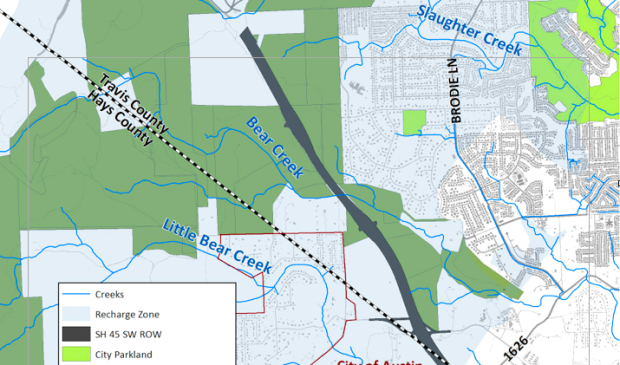Council members still skeptical about SH45 SW
Wednesday, October 1, 2014 by
Tyler Whitson City Council members raised several questions during Tuesday’s work session about the effectiveness and environmental sensitivity of the Texas Department of Transportation’s recommended route for State Highway 45 Southwest.
The conversation took place as part of a joint briefing by the Transportation and Watershed Protection departments on a report that Council requested in a May resolution (See Austin Monitor, June 25). Mayor Lee Leffingwell was not present for the briefing.
A majority of Council is on the record opposing the project, based on concerns that the roadway’s planned route would pose a major environmental risk to the Barton Springs aquifer. Leffingwell is the only current Council member who does not oppose the project.
Council Member Bill Spelman expressed concerns that the report may inflate expectations for the project, since projections don’t take into account potential increases in development that the highway could encourage.
“If what we’re trying to do is stay ahead of our transportation needs,” Spelman said, “if that demand is breathing down our neck, then we’re not staying ahead as much as we think we are.”
Council Member Kathie Tovo focused on the report’s environmental findings. “It sounds like there’s significant evidence that there are some very high environmental risks to the building of this highway,” she said. “Though I was concerned about SH45 before, I’m even more so, based on the discussion of the studies in more depth.”
Transportation Department Director Robert Spillar summed up the report’s findings in an interview with the Monitor. “There will still be congestion even after this project gets built,” he said. “Residents need to understand that there are no silver bullets in terms of mobility, that it really takes a whole toolbox.”
Spillar also noted that the area presents environmental challenges. “I think that as the project moves forward in the evaluation process,” he said, “our analysis needs to be balanced to understand that there are pretty significant environmental issues in this area.”
The report puts forth alternatives that could help reduce congestion in southwest Austin. One would be to construct multiple roundabouts on Brodie Lane between Slaughter Lane and Frate Barker Road.
A second alternative would be to upgrade Brodie Lane and Manchaca Road to what Spillar called “urban arterial environments” with four or five lanes, compared to the current two or three.
Council Member Laura Morrison said the city should consider how potential enhancements to Brodie Lane could improve conditions, regardless of what happens with SH45 SW. She said that, “at a minimum,” the city should begin studying the environmental impacts of such projects.
Staff concluded that, as proposed, SH45 SW would run through a highly sensitive environment. Surface water, which staff reported is “high quality and very sensitive to nutrients,” flows quickly and strongly into groundwater, nearby public water supply wells and Barton Springs.
Staff also pointed out that the area features rare cave species as well as bird habitats near — and possibly in — the proposed SH45 SW right of way. Members are currently conducting a subsurface drainage study of Flint Ridge Cave, which is underneath the proposed route.
Watershed Protection Department Environmental Officer Chuck Lesniak said that, while he believes that TxDOT and its consultants “understand the sensitivity of the area” and intend to minimize or eliminate environmental risks in the project’s design, they issued their Environmental Impact Study “prematurely.”
“One of our major criticisms of the EIS,” Lesniak said, “was just a lack of information on those SH45 specific studies … and the potential mitigation strategies that could be incorporated into the design.”
In addition to identifying alternatives to the proposed SH45 SW route, staff reviewed recent Capital Area Metropolitan Planning Organization and Central Texas Regional Mobility Authority traffic studies and projected the proposed highway’s impacts to south MoPac and Lady Bird Lake bridge.
Staff also reviewed existing environmental surveys of city lands along the proposed highway, compared and contrasted state and federal environmental review processes and requirements, and reviewed TxDOT’s environmental protection measures for state roads and construction sites.
You're a community leader
And we’re honored you look to us for serious, in-depth news. You know a strong community needs local and dedicated watchdog reporting. We’re here for you and that won’t change. Now will you take the powerful next step and support our nonprofit news organization?









